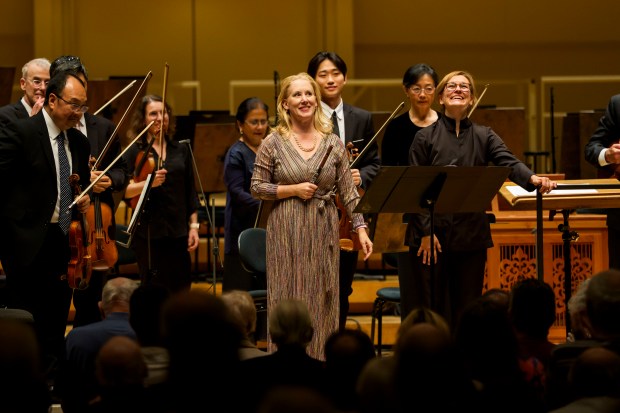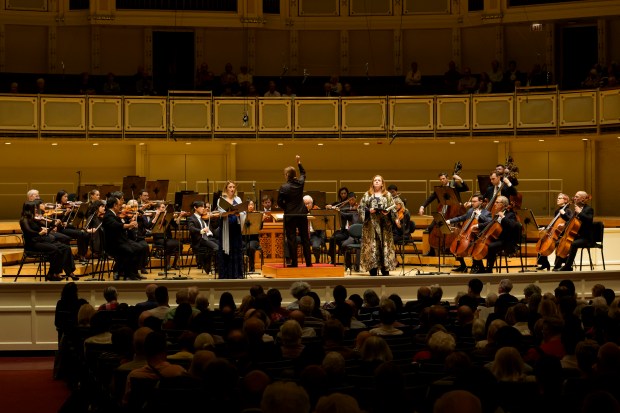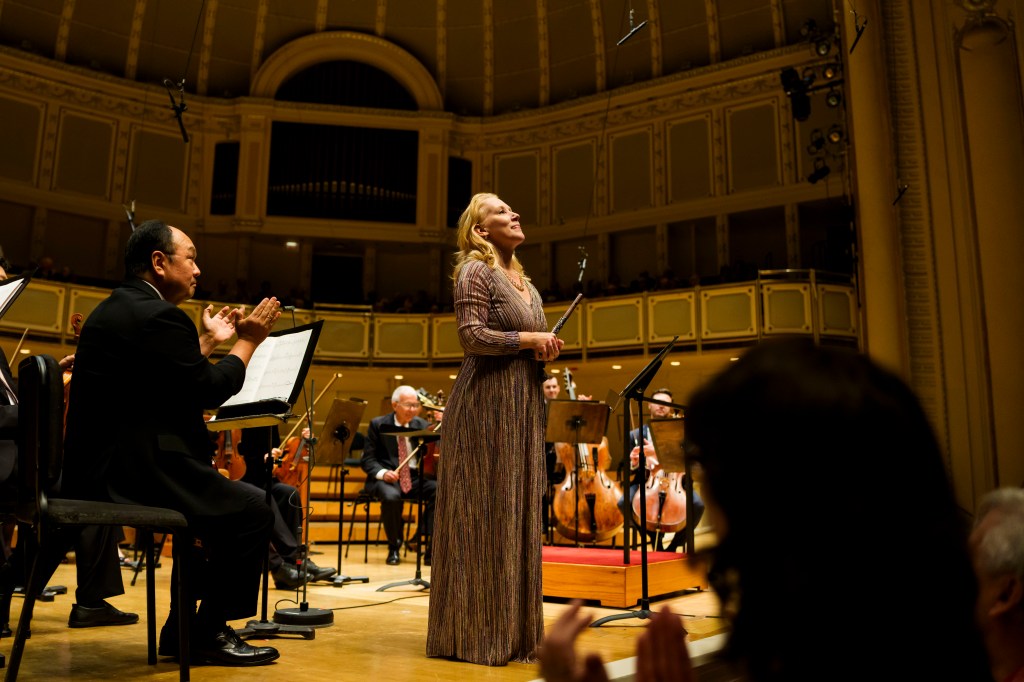Even the Chicago Symphony’s rangiest programs are seldom as varied as the one conductor Daniela Candillari brought to Symphony Center on Friday.
The most familiar work on the program, Samuel Barber’s beloved Adagio for Strings, was among the program’s shortest. Meanwhile, the longest — Giovanni Battista Pergolesi’s “Stabat Mater,” a late Baroque masterpiece — hasn’t been heard at the CSO since the 1980s. Candillari paired those with not one new work, but two: Carlos Simon’s “Fate Now Conquers” and Thea Musgrave’s “Piccolo Play,” a solo essay for the instrument.
That sort of programming is pretty much the norm for Candillari. The Serbian-Slovenian conductor leads Opera Theatre of Saint Louis, a new-works incubator whose commissions include Terence Blanchard’s “Fire Shut Up in My Bones” and “Champion.” (Candilliari also led the former at Lyric in 2022.) And in January, she deftly oversaw the premiere of a new accordion concerto by Nina Shekhar with the St. Louis Symphony, a program which intrigued me enough to make the drive down from Chicago.
Candillari’s debut sticks out at an orchestra maddeningly aloof to contemporary music on its mainstage. That may be changing. After announcing the disappointing “pause” of its MusicNOW series last year, CSO president Jeff Alexander told the Tribune that the organization is pivoting to include more living composers on its full-orchestra programs. (MusicNOW was, effectively, a chamber series.) This season, the first to fully reflect that shift, includes 16 new works — though, it must be noted, just one of those is a premiere.
Will the new strategy go down easy with CSO audiences? Candillari’s program certainly offered a blueprint for success. Widely programmed across the country, Carlos Simon’s music is emotionally immediate and well-crafted — populist enough to be a safe programming choice, but not short of sophistication.
“Fate Now Conquers,” a five-minute curtain raiser from 2019, follows that winning formula. The strings fire off energized linear passages — sometimes handing them off in fast volleys, sometimes overlapping in dense thickets. Underneath them, woodwinds and brass hint at the long, short-short dirge theme from Beethoven’s Seventh Symphony. (Reference to a canon mainstay, however subtle? Check.) It’s the kind of new music all but engineered to go off well at the CSO — though it would have helped had the strings played it with the assurance and guts the score demands, a slight languor hanging over the section like a fog.
Step two in this new-music master plan: Loop in CSO musicians with an avid following. Piccolo player Jennifer Gunn is an anchor of the orchestra’s woodwind section whenever she appears, as dazzling as she is reliable. She last soloed with the orchestra as recently as 2019, in a double-header of piccolo concertos by Vivaldi and Ken Benshoof.
But solo opportunities for woodwinds, brass, percussion and some strings — namely bass and viola — are still few and far between enough for audiences to take note. Whenever someone like Gunn steps into the limelight, you can bet much of the flute-playing populace is boosting the box office, no matter what’s on the menu.
Often treated as a spiky accent in orchestration, the piccolo takes on a thoughtful, almost Debussyian demeanor in Musgrave’s “Piccolo Play.” Originally written with piano accompaniment, the Scottish composer, now 97, expanded the accompaniment to string orchestra in 2022. Gunn debuted that version herself in August of that year, when Chicago hosted the National Flute Association.
Gunn embodied all the expertise one would expect as this version’s originator. Her sound was rounded and lyrical, glassily pristine in the high register but with a pleasant woodiness in its middle and low register. The pointillistic semi-cadenza of the fourth movement (entitled “Les Papillons,” or “The Butterflies”) was a marvel of intricacy and agility. The sixth movement, “Le Bruit de Guerre,” is inspired by Manet’s 1866 painting of a young fifer; Gunn played its final invocation of the “Dies irae” plainchant with fearful desolation, her vibrato like the fluttering of a nervous heart.
During bows, musicians and conductors sometimes hold up their score, directing applause to the piece or composer. At her curtain call, Gunn smiled and waggled her instrument — a tribute to the small yet mighty piccolo.
If pivoting from Musgrave to “Stabat Mater” gave Candillari any stylistic whiplash, she didn’t show it. The conductor cultivated a nonpurist yet transparent tone in the CSO strings, if not always smoothing their blend with the onstage box organ.
Jennifer Johnson Cano’s hearty, potent voice has rightly made her a go-to mezzo soloist at the CSO. On Friday, I occasionally wanted more straight-toned purity where Pergolesi’s orchestration begs for it, including in the vocalists’ very first entrance. But Cano’s presence and tone — particularly in a stark, standout “Fac ut portem” — were otherwise well-suited to Orchestra Hall and the ensemble.
Giulia Semenzato, her soprano colleague, might have overcorrected in the opposite direction. After a strong, bare-hearted “Cuius animam gementem,” she quieted to the vanishing point in “Vidit suum dulcem natum” and seemed to retreat behind her sheet music from that point on. A Baroque specialist, Semenzato may have learned the hard way that Orchestra Hall does soloists no favors if they don’t project.
 The Chicago Symphony Orchestra performs with conductor Daniela Candillari, Jennifer Gunn, piccolo; soprano Giulia Semenzato and Jennifer Johnson Cano, mezzo-soprano at Symphony Center in Chicago on Oct. 3, 2025. (Todd Rosenberg)
The Chicago Symphony Orchestra performs with conductor Daniela Candillari, Jennifer Gunn, piccolo; soprano Giulia Semenzato and Jennifer Johnson Cano, mezzo-soprano at Symphony Center in Chicago on Oct. 3, 2025. (Todd Rosenberg)
 The Chicago Symphony Orchestra performs with conductor Daniela Candillari, Jennifer Gunn, piccolo; soprano Giulia Semenzato and Jennifer Johnson Cano, mezzo-soprano at Symphony Center in Chicago on Oct. 3, 2025. (Todd Rosenberg)
The Chicago Symphony Orchestra performs with conductor Daniela Candillari, Jennifer Gunn, piccolo; soprano Giulia Semenzato and Jennifer Johnson Cano, mezzo-soprano at Symphony Center in Chicago on Oct. 3, 2025. (Todd Rosenberg)
End to end, Candillari was this program’s bedrock. She conducted the whole concert without a baton, a move that has backfired for guest conductors in the recent past. But her beats — graceful yet energized, and dense with expressive intent — left no room for ambiguity. An expansive vocabulary of contours and cutoffs made for an especially intimate Barber’s Adagio for Strings well, the ensemble satiny and well-balanced.
It might be too late to catch Candillari at work by the time you read this. Her CSO engagement is just two nights, as short as subscription cycles go. Until the orchestra gets wise and invites her back for a longer cycle, a friendly reminder: St. Louis is just a four-and-a-half-hour drive.
7:30 p.m. Oct. 5 at Symphony Center, 220 S. Michigan Ave.; 312-294-3000 and cso.org
Hannah Edgar is a freelance critic.
